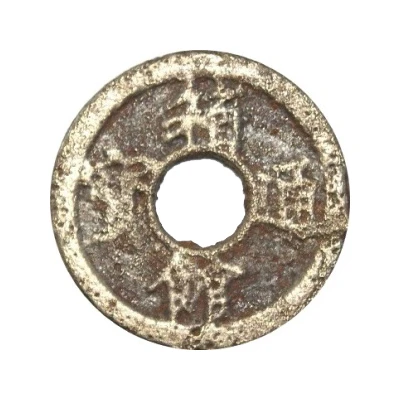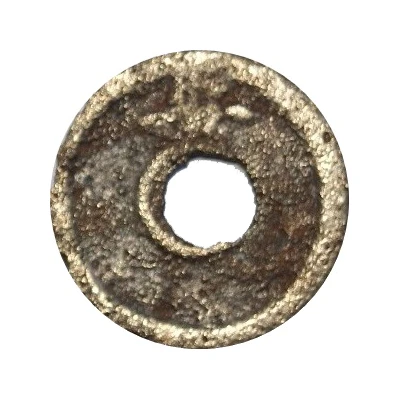


1 Mon "Hakodate-tsūhō" ND
| Iron | 3.35 g | 22 mm |
| Issuer | Ezo Territory (Japanese feudal domains) |
|---|---|
| Type | Standard circulation coin |
| Years | 1856-1858 |
| Value | 1 Mon |
| Currency | Mon (1856-1864) |
| Composition | Iron |
| Weight | 3.35 g |
| Diameter | 22 mm |
| Shape | Round with a round hole |
| Technique | Cast |
| Orientation | Medal alignment ↑↑ |
| Demonetized | Yes |
| Updated | 2024-10-06 |
| Numista | N#64709 |
|---|---|
| Rarity index | 78% |
Reverse
Character above hole as era marker
Lettering: 安
Translation: An(sei)
Engraver: Ota Tamesaburo
Edge
Plain
Comment
Ezo territory was an area under the Matsumae Domain for a long time. However, in 1807, it became a territory under direct control of the Edo government for the reason of maritime defence. Later, Iron Kan'eitsūhō became widely used and trading with the Ainu thrived. But in 1821, the Matsumae Domain was restored due to a policy shift, and using iron coins was banned. Trading with Ainu became barter trade, but due to dishonesty, the Ainu highly demanded using iron coins. Later, after friendship treaty of Japan and the USA had been signed in 1854, the Port of Hakodate was opened. In 1855, it became territory under direct control of the Edo government again. The governor of Hakodate was installed, and the request of permission to produce iron coins was sent for convenience of trade. The permission finally came in mid-1857.
Casting craftsmen were brought to Goryōkaku from Morioka Domain, and the production occurred in 4th year of Ansei at Yachigashira Zeniza (currently around Sumiyoshi-chō). The coins were issued to money changer in Hakodate, Fukuyama (Now Matsumae) and Esashi. For 1 Ryō of gold, the fee of 150 Mon was given to money changer, it was sold at the market price of 1 Ryō = 6800 Mon.
Firstly, they were popular and widely circulated, but later Tenpōtsūhō and Bunkyūtsūhō came into the area, the use of iron coins faded.
Their use was prohibited outside of the region. Copper mother coins are known. The version with the octagonal hole is a rare trial piece.
Interesting fact
The Hakodate-tsūhō coin was the first coin to be issued by the Japanese government, and it was minted in 1856-1858. It was made of iron and had a value of 1 mon. The coin was issued during the Bakumatsu period, which was a time of rapid modernization and Westernization in Japan. The Hakodate-tsūhō coin was designed to replace the traditional Japanese currency, which was based on the Chinese system, and it was intended to be used as a standardized form of currency throughout the country. I hope you find this information helpful!
Price
| Date | Mintage | VG | F | VF | XF | AU | UNC |
|---|---|---|---|---|---|---|---|
| ND (1856-1858) | 100650000 | - | - | - | - | - | - |
Values in the table are based on evaluations by sales realized on Internet platforms. They serve as an indication only for 1 Mon "Hakodate-tsūhō" ND (1856-1858) coin.